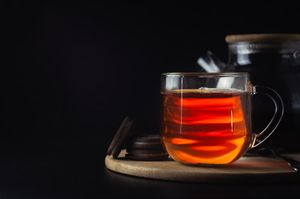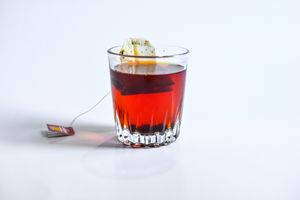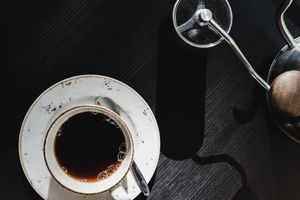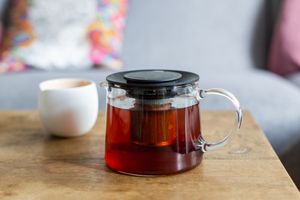Our pick of the best black teas for 2022
By Andrew Warner

What is black tea?
Black tea is one of the most versatile teas around. Compared to green tea or oolong, there are so many different ways to enjoy it, making it an excellent tea for newbies to the tea world. From strong English breakfast tea to creamy, cardamom-spiked masala chai, you’re sure to find one that you love.
The term “black tea” refers to the black color of the leaves once they’ve been completely processed. Once tea leaves have been harvested, they typically undergo a chemical process called oxidation. If you’ve ever noticed an apple turn brown after you’ve sliced into it, you’re familiar with this process. Unlike green teas and oolong teas — which only undergo partial oxidation or none at all — black tea leaves complete the process. This way, the leaves turn from a bright green color to a dark brown or black.
Oxidation doesn’t just change the color of the tea leaves though. It also creates complex chemical compounds like tannins and caffeine, which alter the final flavor profile of the tea. Oxidation gives black tea its characteristic sharp and sometimes bitter quality. It’s also why black tea leaves tend to have particularly high caffeine content.
Black tea has a robust flavor that pairs quite well with milk and sugar. It’s also great on its own and makes for a great base for iced tea. Thanks to its long shelf-life, it’s even played a role as currency in some regions of northeast Asia. Even if you’re new to tea, you’ve likely tried black tea in some capacity before. As the basis for flavored teas like masala chai and Earl Grey, you’ll find it pretty much wherever you can find tea. Whether you prefer the plainer notes of a pure tea or bergamot-perfumed Earl Grey, we’ve got you covered with our list of the best black teas on the market now.
Types of black tea
Black tea has a long history. It’s got an extremely long shelf-life compared to other teas, which has made it an important product of global trade for several centuries. Its worldwide popularity has led it to have several different preparations and processing techniques worldwide.
That’s just one reason why black tea from China might not taste quite the same as black tea from India, for example. This makes it important to try as many different options as possible, especially if you’re a tea newbie. Trying black teas from many different regions will help you become more well-versed in the flavor profiles of different teas. Here’s a brief rundown of some of the major producers of black teas.
Indian
While China is still the largest worldwide producer of tea (including green and oolong, among others), India produces the most black tea out of any other country in the world. Indian black teas — for example, Assam tea — tend to have a malty flavor that pairs especially well with a dash of milk and sugar.
Assam tea is one of the most well-known Indian teas, however, Darjeeling and Nilgiri are also popular Indian black teas. Darjeeling and Nilgiri tend to have more floral notes than Assam tea, which is a bit more neutral in its flavor profile.
In India, tea is called “chai.” In English-speaking countries, this word is practically synonymous with masala chai, a traditional preparation of black tea that’s generally spiced with ginger, cardamom and cinnamon. Warms spices give masala chai its characteristic autumnal flavor profile, which is perfect for a rainy day pick-me-up.
Chinese
China is well-known for its green teas and oolongs, however, the country also produces excellent black tea as well. Chinese black teas tend to be a bit more delicate than Indian black teas, and are best served without milk or sugar.
Keemun is one of the most popular Chinese black teas, along with Lapsang Souchong. Both have slightly smokey flavors, though Keemun is a bit more neutral. Some tea drinkers describe Keemun as having strong floral undertones. On the other hand, Lapsang Souchong has an intensely smokey flavor. Lapsang Souchong also tends to consist of slightly lower quality leaves, as the smoking process can overpower the more sophisticated notes of a high-quality black tea.
Sri Lankan
Although Sri Lanka officially ditched the country name Ceylon in 1948, tea sellers still use the word Ceylon to describe black teas that were harvested and processed in Sri Lanka. Though the country is small, it’s one of the largest tea producers in the world, and for good reason too.
Pure Ceylon teas are of extremely high quality, as the Sri Lanka Tea Board oversees their production. The Tea Board places a lion stamp on the packaging of all Ceylon teas that meet the board’s quality standards. Like teas from India, Ceylon tea pairs quite well with milk and sugar. It also makes for a great base in a traditional cup of masala chai.
Blends
While single-origin teas are often of slightly higher quality, black tea blends are also a great way to get exposure to new, unique flavor profiles. As the name suggests, blends don’t have one particular origin, and instead, consist of tea leaves from different sources. English breakfast tea, for example, is a blend of black teas that are typically sourced from India, Sri Lanka and Kenya.
Sometimes, black tea blends consist of additional spices or flavoring additives — think things like cinnamon, citrus peel, ginger, etc. These additives give these tea blends a flavor that you can’t get with plain black tea — for example, bergamot essential oil adds a citrusy flavor to Earl Grey, while ginger and cardamom add a warm, spicy dimension to masala chai. You can also combine different teas and spices in your kitchen to prepare your own blends if you’re feeling experimental enough to try something new.

Bagged vs. Loose leaf
This is one of those age-old debates of the tea world.
While tea bags may be convenient, loose leaf tea is typically a bit higher quality and more flavorful. When preparing tea bags, tea processors typically grind and cut up tea leaves, which allows the tea to go stale a bit faster. When buying tea bags, you may want to look into a brand like Teapigs, which use the whole tea leaves in their tea sachets. Tea bags that are wrapped in foil or plastic tend to be higher quality since the air-tight packets protect the tea from losing flavor.
Loose leaf tea tends to be a higher quality option, but it can also be a bit more finicky. You’ll want to make sure you follow the directions on a given package extremely closely, to ensure that you get your money’s worth with loose leaf tea. If clean-up’s not your thing, you may prefer the convenience of tea bags — straining loose leaf teas can be a hassle and somewhat of a mess if you’re not careful. If you prefer loose leaf teas, you may find it worthwhile to invest in some empty tea filters, which you can pack with tea leaves as you need them.
Either way, there are high-quality options available in both bagged and loose leaf teas. We recommend tea newbies try out many different options in both tea bags and loose-leaf forms, to see which flavors and styles you prefer.
How to steep black tea
The easiest way to brew black tea is with an electric kettle. An electric kettle with temperature settings is ideal, though you can certainly do without this feature.
Brewing times vary from tea to tea. Darjeeling, for example, requires a brief steep time of just around three minutes. On the other hand, English breakfast tea is better with a longer steep time of around five minutes. It’s best to follow the instructions that come with your tea, but here are some general rules to keep in mind while brewing black tea:
- Unlike green or white teas, black tea needs boiling hot water to extract its robust and toasty flavors. Bring filtered water to a rolling boil in an electric kettle or on the stovetop.
- Add tea leaves or a tea bag to your mug and pour water over. Again, the ideal ratio of water to tea varies. We recommend using two teaspoons of tea leaves for every eight ounces of water, but follow the directions that come with your tea for best results.
- Allow tea leaves to steep for three to five minutes. Add any milk, sugar or other additives as you please.
- Enjoy!
Black tea can also make for a good iced tea. Just double the amount of tea and brew it for a little bit longer, so that it’s a bit more concentrated. Then dilute your concentration with cold water and chill overnight. If you like sweet iced tea, you’ll want to add the desired amount of sugar before chilling the tea, otherwise it may not dissolve properly. Alternatively, you can add a simple syrup after chilling your iced tea overnight — however, this may weaken the overall flavor of the tea a bit.

Best black tea brands
If you’re in the market for a versatile and high-quality black tea but aren’t sure where to begin, look no further. We’ve compiled a list of the best black teas on the market right now. Whether you want something a bit more plain to enjoy with milk and sugar or you want to try something smokey and adventurous, we’ve got you covered. Here’s our selection of the best black tea brands out there in 2022.
Assam
Assam tea is sort of like the gateway into black tea for most tea newbies. Whether you like your tea with a splash of milk and sugar or just plain on its own, Assam tea is the safest choice if you’re not sure what to try first. We recommend trying Taylors of Harrogate, an established and environmentally friendly tea company, which customers say is like a “hug in a mug.”
Ceylon
Sri Lanka is a black tea lover’s heaven. If you’re interested in trying the unique flavors of a cup of the country’s traditional Ceylon tea, there’s no better option than Davidson’s Ceylon loose leaf tea. At just a little more than $1 per ounce, this black tea is a great option if you’re not ready to shill your life’s savings on tea. Plus, tea drinkers say it’s a great base for homemade chai.
Darjeeling
If you want something on the milder side, Darjeeling is a great option. Unlike Ceylon and Assam teas, Darjeeling tends to have a lighter, more floral flavor profile. Darjeeling leaves can have subtle differences in flavor, depending on when they were harvested. We love using Twinings’ Darjeeling tea bags, which blends leaves from multiple harvesting periods.
If you’d like to try leaves that were harvested at different times in the harvesting season, look for “first flush” and “second flush” Darjeelings.
Nilgiri
Unlike Assam tea, this tea is harvested in the southern region of India. The difference in terroir is clear in the flavors of the two teas — Nilgiri has a much more delicate and subtle flavor to it. We recommend Indian Splendor’s Nilgiri tea bags. Unlike most other tea bags, Indian Splendor uses whole leaves, so you get the convenience of bagged tea with the quality of loose leaf tea.
Keemun
This is an excellent introduction to Chinese black teas. Keemun and other Chinese teas tend to have a more delicate flavor profile than the black teas of Southeast Asia. Chinese tea processors developed this style of tea in an effort to mimic the styles of tea popular in England and India. We suggest Pantenger’s organic, loose leaf Keemun, which uses the traditional processing method developed in the 19th Century.
Yunnan
Sometimes called Chinese breakfast tea, Yunnan tea is an excellent coffee substitute to get you going in the morning. Yunnan’s history dates back much further than Keemun. It’s notably less astringent than most other black teas, so if you prefer a milder tea, this is the one for you. We like Numi’s Chinese breakfast tea, which consists of 100% Yunnan black tea.
Lapsang Souchong
This could very well be the most unique tea on our list. A smoked tea, this tea tastes, well, smokey. It’s so smokey, in fact, that it’s also used in Chinese cooking as a flavoring agent in savory dishes like soups and stews. We enjoy Harney & Son’s loose leaf Lapsang Souchong with a little dash of milk.
Hei Cha
This is a special kind of Chinese black tea that undergoes fermentation, completely changing its flavor profile. Hei Cha has a much milder flavor than most other black teas, and is also lower in caffeine. It also has a somewhat strong and pungent aroma that may seem a bit odd at first — you’ll get used to it. Traditionally, this tea is compressed into bricks before packaging, but contemporary tea makers like FGO also sell it in tea bags.
Masala Chai
Once you realize how easy it is to make masala chai at home, you’ll surely ditch the sickeningly sweet chai lattes at Starbucks. With warm, spicy notes of cardamom and ginger, this is our favorite tea to drink during cool winter months. Add a dash of sugar and a splash of cream or milk to Tetley masala chai for the perfect rainy day drink.
English breakfast tea
English breakfast tea actually has its origins in Scotland. It only became associated with England after Queen Victoria brought the tea back to Buckingham Palace after a trip north. Traditionally consisting of Assam, Ceylon and Kenyan black teas, Teapigs’ English breakfast tea is an excellent way to kickstart your day.
Irish breakfast tea
This breakfast tea tends to have a more malty flavor profile than the one above. That’s because this blend has a higher ratio of Assam tea, which gives the final product a bolder, more robust flavor. While Irish breakfast tea doesn’t have any set-in-stone rules, Assam and east African teas feature prominently in Taylors of Harrogate’s Irish breakfast tea. We like this tea with a heavy splash of milk and just a touch of sugar to accent the maltiness of the Assam tea.
Earl Grey
A highly popular British style of tea, Earl Grey has a strong citrusy flavor. Traditionally made with Keemun black tea and bergamot essential oils, some tea vendors use other black teas as the base nowadays. We like Numi’s aged Earl Grey, which features Assam tea. The Assam tea makes it the perfect Earl Grey to pair with milk and sugar, however it’s also great on its own.
Best for milk tea
When it comes to milk tea, a simple yet refined black tea is best. Allegro breakfast blend has a bold flavor profile that holds up well to liberal glugs of milk. Featuring teas from Southeast Asia, customer reviews note that this tea is of especially high quality for a bagged tea. We recommend trying it without milk first, then slowly adding more, to determine just how milky you like your tea.
Best for decaf
Do you like the taste of tea but don’t want to be up all night? If you’re trying to cut back on your caffeine intake, Taylors of Harrogate has you covered. Their decaffeinated breakfast tea has all the flavors you love in a nice cup of black tea, without any of the caffeine rush. This breakfast tea consists mainly of black teas from Africa, which makes for a slightly milder flavor profile. This is the ideal tea for sipping on as you relax before bed.
Best for iced tea
There is nothing better than a nice swig of iced tea on a hot summer day. For something refreshing and cool, we like The Republic of Tea’s ginger and peach infused black tea. This tea is great on its own over a glass of ice, but it’s even better with a light squeeze of lemon juice and a dash of sugar for the ultimate summer refresher.

Conclusion
The above teas are a perfect addition to your tea cabinet — we recommend sampling a few to figure out which flavors you like best. Whether you take your tea with milk and a lot of sugar, or like to let the tea leaves speak for themselves, you’re sure to find something you love among the teas listed above.
